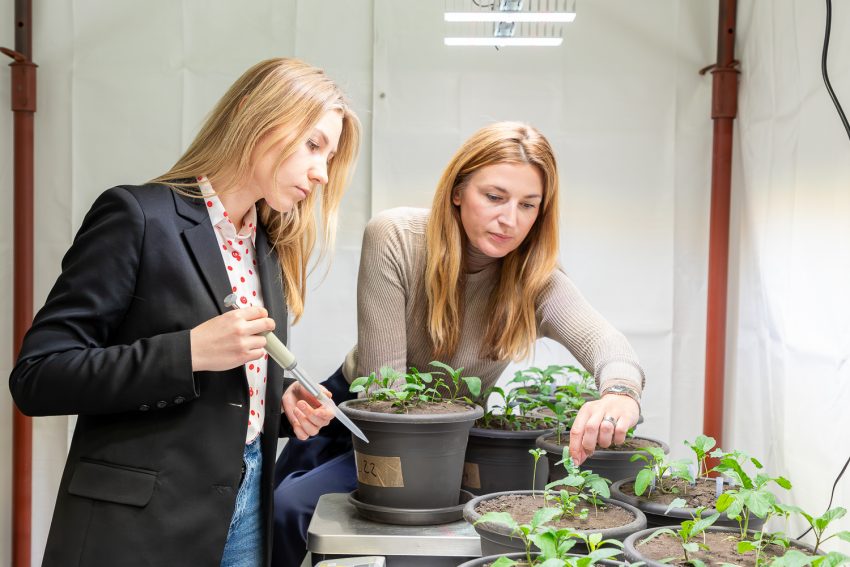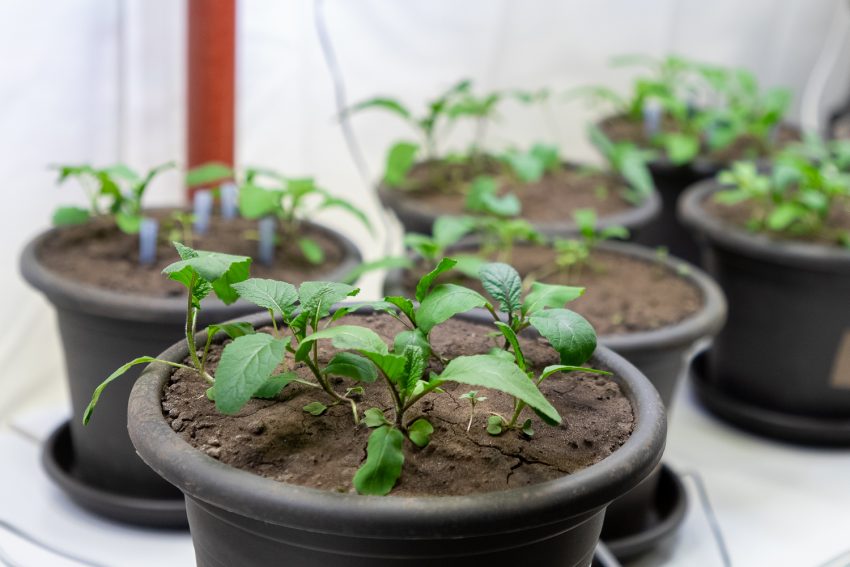Soils in a state of war TU scientists examine Ukrainian soils for pollutant residues
How does war change the earth beneath our feet? Dr. Anastasiia Splodytel and Professor Magdalena Sut-Lohmann at Technical University of Braunschweig are investigating this question. Their goal is to develop a tool for land use and management in war-affected ecosystems, as there are currently no such models in Ukraine. Their work involves life-threatening sampling, complex laboratory analyses and sustainable approaches to soil remediation.

Together, Dr. Anastasiia Splodytel and Professor Magdalena Sut-Lohmann are researching how war is changing Ukrainian soils at TU Braunschweig. Photo credit: Kristina Rottig/TU Braunschweig
When Dr. Anastasiia Splodytel takes soil samples in Ukraine, she sometimes has only a minute. Sixty seconds to decide where to dig, what to take with her and how to escape safely. Sixty seconds until the shelling begins. And yet she returns with soil. This soil, which was once often fertile black earth known as chernozem, is now contaminated in many regions with heavy metals, explosive residues and pollutants such as dioxins. It has been partly mined and is unusable for human purposes.
Thanks to the Philipp Schwartz Initiative of the Alexander von Humboldt Foundation, Dr. Splodytel is working with Professor Sut-Lohmann, Head of the Department of Soil Sciences at the Institute of Geoecology, to find sustainable solutions: How can war-contaminated soils be healed and made usable again?
Hurdles from the sample to the laboratory
The work begins with analysis with enormous challenges. Many samples can only be taken at great risk, often relying on the trust of local guides. “You often have to rely on intuition and a little luck,” says Dr. Splodytel. Working in such areas is only possible through established contacts with experts, the military, communities, demining organisations, and local researchers.
However, the challenges do not end with sampling. Dr. Splodytel’s laboratory in Ukraine has been out of operation since the massive shelling, and exporting samples is complicated. For a long time, analyses could only be carried out through personal networks. “There are more challenges than can be put into words,” she says, yet she is convinced: “If this research can make even the smallest contribution, it is worth continuing.”
The chemistry of war
In the laboratory, the two researchers analyse how military operations alter soil chemistry. Their results from 2017 to 2025 are alarming: 35 percent of samples contain toxic elements at concentrations more than a hundred times higher than background levels. Areas around destroyed industrial facilities, regions that have suffered massive air strikes and areas flooded after the destruction of the Kakhovka Dam in 2023 are particularly affected. There, heavy metal levels exceed permissible limits by ten to seventy times. Although explosion craters are often less chemically contaminated, they pose other risks, such as destroyed soil structure, disrupted water balance, and loss of humus and biodiversity. Unlike previous wars, modern warfare uses a wide variety of complex explosives, the mixtures of which interact in unpredictable and highly dangerous ways.
Food supply at risk
Rapeseed plants are currently growing in a basement room in Braunschweig as part of a test to determine which pollutants are absorbed by crops, how much remains in the soil and the level of danger to agriculture. One of the key questions is whether crops can be grown again immediately after ordnance clearance. The urgency is obvious: Ukrainian agriculture, long known as the “breadbasket of Europe”, plays a crucial role in global food security. The war has weakened this role, but Ukraine remains active in the global agricultural market. The size of its future share also depends on how quickly and successfully the soil is remediated – a process that could take decades and may never be fully successful.

Rapeseed plants are being used to investigate how crops deal with pollutants. Photo credit: Kristina Rottig/TU Braunschweig
Sustainable remediation methods offer hope. Professor Sut-Lohmann and Dr. Splodytel are particularly focused on phytostabilisation, which involves targeted planting to reduce the mobility and bioavailability of pollutants. Another promising approach is assisted phytoremediation, in which plant-based processes are supported by microorganisms such as mycorrhizal fungi, as well as soil additives such as biochar. “Such methods are often slow, but cost-effective and sustainable. They promote more comprehensive regeneration processes,” says Professor Sut-Lohmann. “In some cases, the land can even continue to be farmed during this process.”
Long-term goals
The researchers aim to develop a land use and management tool that can be used to systematically assess war-affected areas and integrate them into future land use planning. Since 2021, spatial planning plans have been developed for Ukrainian municipalities as part of the nationwide decentralisation reform. These plans also include landscape planning, providing an opportunity to incorporate research results directly into concrete restoration strategies.
Dr. Splodytel also intends to collaborate with scientists from other countries that have experienced armed conflict. Together, they could compare the effects of war on soils under different conditions and time periods, using this information to develop universal strategies for restoring post-war land. For the two scientists, this research is also a personal mission. Inspired by her doctoral supervisor Liudmyla Sorokina, who conducted research in contaminated areas after the Chernobyl accident (1986), Dr. Splodytel knows: “Science needs more than data. It needs moral strength, responsibility, and consistency.”
The war has changed many things for Dr. Splodytel. “For some time now, only today has existed for me,” she says. “Every day has enough meaning to devote yourself to the work you love.” The humanity among her colleagues, international cooperation and Professor Sut-Lohmann’s mentorship give her stability – and perhaps not only rapeseed is growing in a basement laboratory in Braunschweig, but also the first seed of a more hopeful future.
